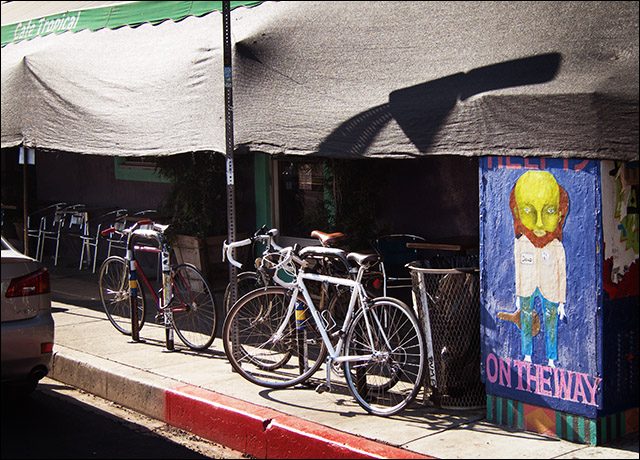 On my way home from NELA, I often take Rollers’ Wiggle out of Chinatown to Sunset Boulevard. In doing so, I pass near the intersection of Sunset and Figueroa. And that has set me thinking of the metaphrical intersection of those two streets: Sunset Boulevard, through Echo Park and Silverlake, a thriving valley of successful small businesses, vibrant street life, and a busy bicycle culture, and Flying Pigeon’s own North Figueroa Street, a dreary speedway whose marginal businesses hang on, often, by a thread, while cut-through traffic zooms past without a second glance, and the neighborhood’s cyclists and walkers cower on side streets.
On my way home from NELA, I often take Rollers’ Wiggle out of Chinatown to Sunset Boulevard. In doing so, I pass near the intersection of Sunset and Figueroa. And that has set me thinking of the metaphrical intersection of those two streets: Sunset Boulevard, through Echo Park and Silverlake, a thriving valley of successful small businesses, vibrant street life, and a busy bicycle culture, and Flying Pigeon’s own North Figueroa Street, a dreary speedway whose marginal businesses hang on, often, by a thread, while cut-through traffic zooms past without a second glance, and the neighborhood’s cyclists and walkers cower on side streets.
I explored what makes that eastern stretch of Sunset so attractive to cyclists in a post on Bicycle Fixation a few days ago, but lately I’ve been wondering if it wasn’t more likely that the bicycle culture built the thriving street, and that they now reinforce each other in a virtuous circle.
After all, those bike lanes have resided on Sunset for years and years now. And the experiences of New York City show that residents need about three years to accustom themselves to using the lanes, after which business starts booming.
I used to work on Sunset Boulevard in Silver Lake, when I lived in Echo Park over three decades past. The area was not a happening place back then, though it still had its hipsters—plenty of artists and musicians, both emerging and established—and a number of fading, dreary shops and restaurants. Much like today’s North Fig! The motorcycle shop where I was a repairman was right at Sunset and Micheltorena, and the closest store was Soohoo’s grocery, a tiny alcove staffed by an ancient Chinese gentleman selling little more than potato chips, cigarettes, and stale orange juice.
It is quite different now, with (if I may quote myself) “a plethora of small shops, bars, restaurants, and service establishments, typically offering unique and often locally-made products and a stunning range of cuisines and atmospheres, staffed by friendly and lively employees. There are almost no ‘national chains,’ with their standardized offerings and clock-punching wage-slaves; nearly every business owner and his or her employees are as much a part of the neighborhood as their customers. And there are dozens upon dozens upon dozens of these shops and restaurants, all different, all very good. As a result, hundreds of interesting people roll and stroll from storefront to shop to plaza all day long. It’s a place to go to, and it’s by far easier to go there, and navigate through the wealth of choices, by bicycle than by car.”
There’s something else that Sunset offers, too, something I think we’ve all overlooked: natural traffic calming. The street has relatively narrow lanes, and plenty of curves and crests along this section as it meanders through the hills. So even though there’s nothing more for us than standard Door Zone Bike Lanes, there are still plenty of folks riding bicycles, including women. In fact, my informal counts often tally more women than men riding along this four-lane thoroughfare.
North Figueroa doesn’t have the benefits of hills that force it to wind, but the same traffic-calming could be achieved by the proposed road diet that rookie council member Cedillo seems to be holding up. This road diet would be accompanied by bike lanes, and the neighborhood’s revitalization could begin.
That will happen only if the striping is actually implemented, of course. Till then, streets such as Sunset Boulevard just over the hills of Elysian Park from NELA, or wildly successful Main Street in Santa Monica, will get all the love, the glory, and the dollars—while North Figueroa continues to fade into the smog….